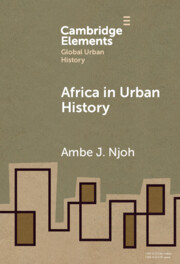71 results
Why and How to Walk a City
-
- Journal:
- Asia-Pacific Journal / Volume 21 / Issue 12 / December 2023
- Published online by Cambridge University Press:
- 14 March 2025, e1
-
- Article
- Export citation

Africa in Urban History
-
- Published online:
- 30 January 2025
- Print publication:
- 30 January 2025
-
- Element
-
- You have access
- HTML
- Export citation
Urban History in Kumase, Ghana: A Note on Archives
-
- Journal:
- History in Africa , First View
- Published online by Cambridge University Press:
- 20 January 2025, pp. 1-14
-
- Article
-
- You have access
- Open access
- HTML
- Export citation
7 - From Slavery to Feudalism: The Great Hypothesis
- from Part II - From Masters to Lords
-
- Book:
- From Masters of Slaves to Lords of Lands
- Published online:
- 28 November 2024
- Print publication:
- 16 January 2025, pp 236-290
-
- Chapter
- Export citation

Making Mao's Steelworks
- Industrial Manchuria and the Transnational Origins of Chinese Socialism
-
- Published online:
- 19 December 2024
- Print publication:
- 05 December 2024
12 - Reflections
-
- Book:
- World Cities in History
- Published online:
- 12 December 2024
- Print publication:
- 19 December 2024, pp 284-293
-
- Chapter
- Export citation
6 - Tale of Two Chang’ans
-
- Book:
- World Cities in History
- Published online:
- 12 December 2024
- Print publication:
- 19 December 2024, pp 125-153
-
- Chapter
- Export citation
1 - Introduction
-
- Book:
- World Cities in History
- Published online:
- 12 December 2024
- Print publication:
- 19 December 2024, pp 1-21
-
- Chapter
-
- You have access
- HTML
- Export citation
7 - City-State Civilizations
-
- Book:
- World Cities in History
- Published online:
- 12 December 2024
- Print publication:
- 19 December 2024, pp 154-179
-
- Chapter
- Export citation
2 - Origins of Urbanization
-
- Book:
- World Cities in History
- Published online:
- 12 December 2024
- Print publication:
- 19 December 2024, pp 22-46
-
- Chapter
- Export citation
9 - Italian Communes and the Rise of Venice
-
- Book:
- World Cities in History
- Published online:
- 12 December 2024
- Print publication:
- 19 December 2024, pp 203-230
-
- Chapter
- Export citation
5 - City Networks in the Roman Empire
-
- Book:
- World Cities in History
- Published online:
- 12 December 2024
- Print publication:
- 19 December 2024, pp 96-124
-
- Chapter
- Export citation
3 - Agora and Emporia
-
- Book:
- World Cities in History
- Published online:
- 12 December 2024
- Print publication:
- 19 December 2024, pp 47-71
-
- Chapter
- Export citation
4 - Alexandria, Alpha City
-
- Book:
- World Cities in History
- Published online:
- 12 December 2024
- Print publication:
- 19 December 2024, pp 72-95
-
- Chapter
- Export citation
8 - Baghdad
-
- Book:
- World Cities in History
- Published online:
- 12 December 2024
- Print publication:
- 19 December 2024, pp 180-202
-
- Chapter
- Export citation
11 - Urban Power in the Dutch Empire
-
- Book:
- World Cities in History
- Published online:
- 12 December 2024
- Print publication:
- 19 December 2024, pp 257-283
-
- Chapter
- Export citation

World Cities in History
- Urban Networks from Ancient Mesopotamia to the Dutch Empire
-
- Published online:
- 12 December 2024
- Print publication:
- 19 December 2024
Coda
-
- Book:
- Slavery and Freedom in Black Thought in the Early Spanish Atlantic
- Published online:
- 28 November 2024
- Print publication:
- 05 December 2024, pp 252-264
-
- Chapter
- Export citation
Introduction
-
- Book:
- Late Ottoman Gaza
- Published online:
- 07 November 2024
- Print publication:
- 21 November 2024, pp 1-33
-
- Chapter
- Export citation

Late Ottoman Gaza
- An Eastern Mediterranean Hub in Transformation
-
- Published online:
- 07 November 2024
- Print publication:
- 21 November 2024

